-
PDF
- Split View
-
Views
-
Cite
Cite
Federica Capranico, Philipp M. Merkel, Björn Malte Schäfer, Intrinsic ellipticity correlations of galaxies: models, likelihoods and interplay with weak lensing, Monthly Notices of the Royal Astronomical Society, Volume 435, Issue 1, 11 October 2013, Pages 194–206, https://doi.org/10.1093/mnras/stt1269
Close - Share Icon Share
Abstract
Subject of this paper is the statistical properties of ellipticity alignments between galaxies evoked by their coupled angular momenta. Starting from physical angular momentum models, we bridge the gap towards ellipticity correlations, ellipticity spectra and derived quantities such as aperture moments, comparing the intrinsic signals with those generated by gravitational lensing, with the projected galaxy sample of Euclid in mind. We investigate the dependence of intrinsic ellipticity correlations on cosmological parameters and show that intrinsic ellipticity correlations give rise to non-Gaussian likelihoods as a result of non-linear functional dependences. Comparing intrinsic ellipticity spectra to weak lensing spectra we quantify the magnitude of their contaminating effect on the estimation of cosmological parameters and find that biases on dark energy parameters are very small in an angular momentum-based model in contrast to the linear alignment model commonly used. Finally, we quantify whether intrinsic ellipticities can be measured in the presence of the much stronger weak lensing induced ellipticity correlations, if prior knowledge on a cosmological model is assumed.
1 INTRODUCTION
Weak cosmic shear, i.e. lensing by the gravitational field of the cosmic matter distribution (Blandford et al. 1991; Seitz & Schneider 1994; Seitz, Schneider & Ehlers 1994; Kamionkowski et al. 1998), is considered to be an excellent probe of structure formation processes, precision measurements of cosmological parameters (Hu 1999, 2002a,b; Takada & White 2004; Hannestad, Tu & Wong 2006) and the influence of dark energy on cosmic structure formation (Huterer & Turner 2001; Huterer 2002, 2010; Amara & Kitching 2011; Kunz 2012). The primary observables are ellipticity correlation functions or their Fourier counterparts (Jain & Seljak 1997; Hu & Tegmark 1999; Hu & White 2001; Hu & Jain 2004). These shape correlations have been first detected by a number of research groups more than 10 years ago (Bacon, Refregier & Ellis 2000; Kaiser, Wilson & Luppino 2000; Van Waerbeke et al. 2000; Wittman et al. 2000) and are now routinely used for parameter estimation. Correlations in shapes of galaxies are introduced because light rays from neighbouring galaxies experience correlation distortions due to correlations in the tidal fields through which the respective rays propagate. A common assumption is the absence of intrinsic correlations such that any positive shape correlation can be attributed to the gravitational lensing effect. This hypothesis, however, might be flawed as there are physical mechanisms by which galaxies are intrinsically shape correlated: due to the fact that neighbouring galaxies form from correlated initial conditions, their respective angular momenta are correlated (Croft & Metzler 2000; Heavens, Refregier & Heymans 2000; Crittenden et al. 2001; Mackey, White & Kamionkowski 2002). Assuming that the galactic discs are established with their symmetry axes collinear with the host haloes’ angular momentum directions one would observe galaxies at correlated angles of inclination and therefore with correlated ellipticities.
If galaxy ellipticities are in fact described by an alignment model linear in the tidal fields, then cosmological parameters, in particular the dark energy equation of state parameters would be severely biased (Bridle & King 2007; Joachimi & Bridle 2010; Kirk, Bridle & Schneider 2010; Kirk et al. 2011). Apart from ellipticity correlations themselves, ellipticity–position correlations were affected and ellipticity data would exhibit cross-correlations between intrinsic ellipticities and weak lensing (see, in particular, Hirata & Seljak 2004).
There are basically four ways of dealing with intrinsic alignments. First, they can be removed from data by using the fact that they are a small-scale phenomenon (Heymans & Heavens 2003; King & Schneider 2002, 2003; King 2005), which takes place at the cost of increasing statistical uncertainties. Secondly, one can take advantage of the fact that intrinsic alignments have different statistical properties in comparison to weak lensing ellipticity correlations (Crittenden et al. 2002; King & Schneider 2003), most notably it is possible to use the statistics of vortical excitations in the ellipticity field which are exclusively sourced by intrinsic alignments. Thirdly, one can design line-of-sight weightings that null out contributions due to intrinsic alignments (King 2005; Joachimi & Schneider 2008, 2009), which marginally increase statistical uncertainties on cosmological parameters. Parameter inference from spectra that result from data in this way still yields unbiased estimates. Finally, one can parametrize the intrinsic alignment contribution to weak lensing data and have those model parameters be determined by data alongside the cosmological parameters under consideration. Marginalization over the parameters entering the intrinsic alignment model then propagates the statistical errors of the alignment model on to the cosmological model. With a physically correct alignment model the estimates of cosmological parameters will remain unbiased. The feasibility of this approach under the assumption of Gaussian likelihoods has been demonstrated (Bridle & King 2007; Bernstein 2009; Joachimi & Bridle 2010; Kirk et al. 2010; Laszlo et al. 2012).
The motivation of this work was to explore intrinsic alignment effects and their observable properties in angular momentum-based alignment models. In these models, the ellipticity is quadratic in the tidal shear field and because they use in principle a mechanical model of angular momentum generation and ellipticity alignment, the model parameters can be constrained from information other than ellipticity data. We will need two physically meaningful variables: a parameter which is related to the angular momentum model and whose value can be measured in structure formation simulations and a disc morphology parameter which is accessible in galaxy surveys. Clearly, quadratic alignment models will differ in their prediction of ellipticity correlations compared to linear alignment models. Together with the above results employing linear alignment models we hope to complete the view on intrinsic alignments and their relevance for future weak lensing surveys.
The aim of this paper is threefold. (i) We investigate and compare two angular momentum-based alignment models in their predictions for ellipticity correlations and formulate these predictions in terms of ellipticity correlation functions, ellipticity spectra and the scale dependence of the variance of the ellipticity fields and compare these predictions with the equivalent quantities sourced by weak gravitational lensing (Sections 2 and 3). (ii) The dependence of the two ellipticity models in consideration on cosmological parameters is investigated and their likelihoods are derived. With this knowledge, we quantify the contamination of weak lensing data with an intrinsic alignment contribution and quantify how these contaminations affect the estimation of cosmological parameters (Section 4). (iii) We investigate if there is a possibility of observing intrinsic correlations in the presence of much stronger lensing induced ellipticity correlations and develop statistical methods for answering these questions (Section 5). Throughout we will focus on intrinsic ellipticity correlations caused by correlated angular momenta, which is an applicable model for spiral galaxies. Those intrinsic alignments are proportional to the squared tidal field, in contrast to the linear alignment model valid for elliptical galaxies. In this limit, we neglect cross-correlations between intrinsic ellipticity alignments with the tidal field and gravitational lensing, as those correlations are proportional to the expectation value of the tidal field cubed, which vanishes in the case of Gaussian statistics. Specifically, we consider the case of Euclid's weak lensing survey (Amendola et al. 2012).
The reference cosmological model used is a spatially flat w cold dark matter (wCDM) cosmology with Gaussian adiabatic initial perturbations in the cold dark matter (CDM) density field. The parameter choice is motivated by the Wilkinson Microwave Anisotropy Probe 7 results (Komatsu et al. 2011; Larson et al. 2011): Ωm = 0.25, ns = 1, σ8 = 0.8, Ωb = 0.04 and H0 = 100 h km s−1 Mpc−1, with h = 0.72. The dark energy equation of state is set to w = −0.95.
2 COSMOLOGY
2.1 Dark energy cosmologies
2.2 CDM power spectrum
2.3 Linear structure growth
2.4 Angular momenta from tidal shearing
The Levi-Civita symbol in equation (8) generates the interesting misalignment property between the shear and inertia eigensystems which is required for generating angular momentum: only the antisymmetric contribution |$X^-_{\beta \gamma }$|, derived from the commutator |$X^-_{\beta \gamma } = [I_{\beta \gamma }, \Phi _{\beta \gamma }]$|, to the product between the tensors Iβγ and Φβγ is non-vanishing in contraction with the antisymmetric ϵαβγ and therefore relevant for angular momentum generation. The symmetric contribution |$X^+_{\beta \gamma }$|, which can be isolated using the anticommutator |$X^+_{\beta \gamma } = \lbrace I_{\beta \gamma }, \Phi _{\beta \gamma }\rbrace$| cancels in the contraction. This means that for angular momentum build-up, the tidal shear and the inertia tensors are not allowed to have a common eigensystem and are skewed relative to each other (Schäfer 2009; Schäfer & Merkel 2012). Likewise, degeneracies in this relation evoked by spatial symmetries in the two tensors can prohibit the generation of angular momentum. Alternative models of galaxy angular momenta assume that the haloes are spun up by non-central, anisotropic infall in filaments (see, for instance, Pichon et al. 2010; Kimm et al. 2011; Codis et al. 2012).
2.5 Galaxy ellipticities
It should be emphasized that the assumption of a galactic disc forming perpendicularly to the host halo angular momentum direction is a very strong one, which seems suggestive but has only little support from structure formation simulations. In fact, a number of studies point at possibly large misalignments and underline the complexity of the baryonic physics on galactic scales (van den Bosch et al. 2002; Navarro, Abadi & Steinmetz 2004; Bailin & Steinmetz 2005; Bailin et al. 2005; Mayer, Governato & Kaufmann 2008; Kimm et al. 2011). The disc thickness and the degree of misalignment between the symmetry axis of the galactic disc and the angular momentum axis of the host halo therefore have a decisive role in the description of galaxy formation, and appear to be degenerate physical quantities. In our analysis, misalignments could be incorporated in choosing a smaller value for the disc thickness parameter α, which will play the role of normalizing the ellipticity spectra. The angular momentum-based alignment model is only able to capture the physics of tidal alignment of spiral galaxies. In the case of elliptical galaxies, a model which is linear in the tidal shear is more appropriate.
2.6 Weak gravitational lensing
3 ELLIPTICITY CORRELATIONS
3.1 Angular momentum induced ellipticity correlations
The idea behind intrinsic correlations is that neighbouring galaxies build up their angular momenta with correlated tidal shears because the galaxy separation is typically smaller than the correlation length of the tidal shear field. Under the assumption that the galactic disc orients itself perpendicular to the angular momentum direction of the host halo (for a review on angular momenta of galactic discs, see Bryan et al. 2012; Romanowsky & Fall 2012), one perceives neighbouring galactic discs under correlated angles of inclination, and therefore the apparent shapes are correlated, which is measured in terms of ellipticities. We use two ellipticity correlation models in this paper, which are both constructed on the idea of correlated angular momenta, but which differ in their particular ansatz. The first model, proposed by Crittenden et al. (2001) establishes the link between the angular momentum direction to the tidal shear field in a random process in real space, whereas the second model, which is due to Mackey et al. (2002), directly formulates the ellipticity field in Fourier space, which makes it easier to quantify ellipticity spectra, but whose parametrization is not as clear as in the first case.
3.1.1 Ellipticity correlations
3.1.2 Configuration space approach
In this work, we use the angular momentum-based ellipticity correlation model proposed by Crittenden et al. (2001) (referred to as the CNPT model), who trace ellipticity correlations back to tidal shear correlations using the conditional probability distribution |$p(\boldsymbol {L}|\Phi _{\alpha \beta })\, \mathrm{d}\boldsymbol {L}$| introduced by Lee & Pen (2001): in this model, the distribution |$p(\boldsymbol {L}|\Phi _{\alpha \beta })\, \mathrm{d}\boldsymbol {L}$| is assumed as being Gaussian which is then being marginalized over the magnitude of the angular momentum vector, retaining only its directional dependence. Writing down the ellipticity components as a function of the angular momentum direction and employing the covariance 〈LαLβ〉 as a function of the squared tidal shear tensor, as advocated by Lee and Pen, it is possible to relate the tidal shear correlations to the spectrum of the density field.
3.1.3 Fourier approach
We extend our analysis by the approach of Mackey et al. (2002, hereafter MWK). Similar to Crittenden et al. (2001) they also work in the framework of tidal torque theory and relate intrinsic ellipticity to angular momentum assuming that the disc of a galaxy forms perpendicular to its spin axis. However, when computing the angular momentum the MWK model entirely neglects any correlation between the tidal field and the tensor of inertia. They argue that due to the different correlation lengths involved (while the correlations for the inertia tensor primarily arise from smaller scales the correlations in the tidal field are long ranged) a successive averaging process is permissible. First, they perform an average over inertia tensors then over the tidal field expecting the ellipticity correlation arising from long-range correlations of the latter. In contrast to this, the CNPT model takes explicitly the correlations of the inertia tensor and the tidal field via the misalignment parameter a into account.
MWK determine the constant C by computing the expectation value of the squared angular momentum modulus and adjusting C to match the mean-square source ellipticity typically observed in galaxy surveys. For our purpose, however, it makes more sense to choose C in such a way that the angular power spectra obtained with the two different approaches coincide on largest scales. This is justified by the expectation that the large-scale power will be least affected by the differences in the two approaches under consideration. Hence, we first compute the spectra using formulae (18) and (19) for appropriately chosen misalignment parameter a and galaxy thickness parameter α and subsequently determine C, so that the two models yield identical predictions for the variance of the intrinsic ellipticity field on large scales.
3.1.4 Comparison of the two ellipticity models
The ellipticity correlation functions C++(θ) and C××(θ) resulting from both models are plotted in Fig. 1 as a function of angle of separation θ, where the projection was carried out for the Euclid galaxy redshift distribution. The plot suggests correlation lengths of ∼10 arcmin for the ellipticity field and shows that under the normalizations chosen, the correlation functions resulting from the CNPT model achieves 50 per cent higher amplitudes in comparison to those predicted by the MWK model, but otherwise the general shape is in very good agreement.
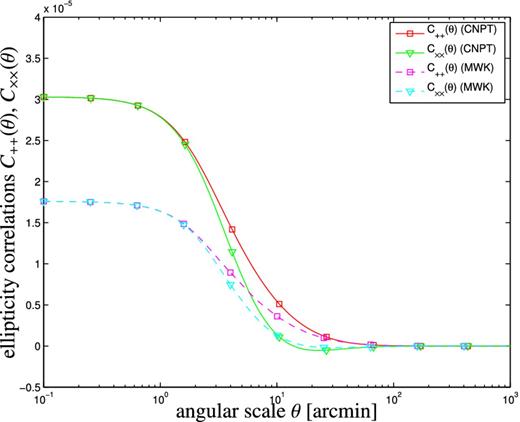
Angular ellipticity correlation functions C++(θ) (green and magenta lines) and C××(θ) (red and cyan lines), for a smoothing scale of M = 1011 M⊙ h−1, a misalignment parameter a = 0.25 and a disc thickness of α = 0.75. The correlation functions were derived using the CNPT and MWK models with the relative normalization as discussed in the text.
Computing the spectra |$C_E^\epsilon (\ell )$| and |$C_B^\epsilon (\ell )$| yields Fig. 2, where for comparison the linear and non-linear spectra Cκ(ℓ) for the weak lensing convergence and the Euclid shape noise levels |$\sigma _\epsilon ^2/n$| are plotted. The shape of the ellipticity spectra shows constant amplitudes up to scales of ℓ ∼ 300, where individual ellipticities are uncorrelated, and correlations between ellipticities are present on smaller angular scales. The spectra exhibit a wide maximum on multipoles of ℓ ∼ 103 before dropping in amplitude, which is caused by imposing the mass cutoff. For comparison and motivating our analysis, we plot predictions for the weak lensing spectrum Cκ(ℓ) for linear and non-linear CDM spectra, as well as the anticipated shot noise for Euclid. Clearly, intrinsic ellipticity correlations are subdominant compared to weak lensing induced ellipticity correlations, but can in amplitude amount to up to 30 per cent of the lensing signal on multipoles of ℓ ≃ 103 before the shape noise makes measurements difficult. Comparing the two ellipticity models show that, if the normalization is chosen as explained, the MWK model predicts lower spectra than the model by CNPT by about 50 per cent on high multipoles as in the case of the correlation function at small separations, but both models predict similar ratios between |$C^\epsilon _E(\ell )$| and |$C^\epsilon _B(\ell )$| amounting to about a factor of 5 at high multipoles. Interestingly, intrinsic ellipticity correlations would dominate over the weak lensing signal if the lensing prediction was derived using linear structure growth only. Comparing the spectra |$C^\epsilon _E(\ell )$| and Cκ(ℓ) with the shape noise levels of Euclid clearly demonstrate the importance of intrinsic ellipticity correlations in weak lensing data.

Ellipticity spectra |$C_E^\epsilon (\ell )$| (green and magenta lines) and |$C_B^\epsilon (\ell )$| (red and cyan lines) derived with the CNPT and MWK models, with weak convergence power spectrum Cκ(l), both linear and non-linear (black dashed and solid lines, respectively), and the Euclid shape noise |$\sigma _\epsilon ^2/\bar{n}$|, with |$10^n\times \sigma _\epsilon ^2/\bar{n}$|, n = 0, 1, 2 (blue dashed lines).
The B-mode spectrum |$C^\epsilon _B(\ell )$|, which is sourced by intrinsic alignments, is smaller by more than one order of magnitude compared to the E-mode spectrum |$C^\epsilon _E(\ell )$| at high multipoles but might dominate over other higher order lensing effects which are able to excite parity-violating modes in the ellipticity field such as source-lens clustering (Schneider et al. 2002), multiple lensing along the line of sight or violations of the Born approximation (Cooray & Hu 2002; Shapiro & Cooray 2006; Schäfer et al. 2012).
3.2 Variance in apertures
In Fig. 3 we show, how the aperture-weighted variances of the intrinsic ellipticity field should behave in the Euclid galaxy sample as a function of angular scale in comparison to that of the weak lensing field. We consider both tangential and radial shears and compare the results between the two different intrinsic ellipiticity models.
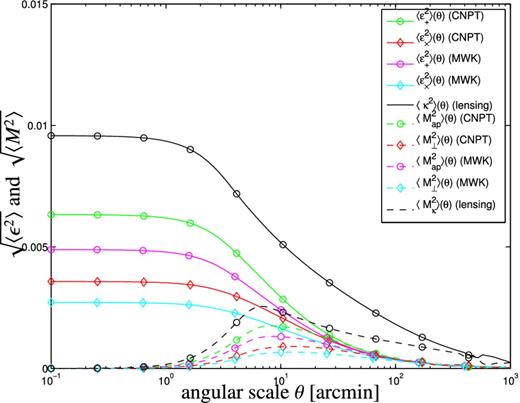
Standard deviation of the averaged ellipticity and aperture mass as a function of aperture size θ for the CNPT and MWK models: tangential ellipticity |$\langle \epsilon _+^2\rangle$| (solid green and magenta lines), radial ellipticity |$\langle \epsilon _\times ^2\rangle$| (solid red and cyan lines), aperture mass |$\langle M_\mathrm{ap}^2\rangle$| (dashed green and magenta lines) along with |$\langle M_\perp ^2\rangle$| (dashed red and cyan lines), all for the Euclid galaxy sample in comparison to the same quantities derived from the weak lensing convergence (corresponding black lines).
The aperture-weighted variances derived from intrinsic ellipticities decrease in magnitude which of course is a generally expected behaviour caused by the weighting functions Wn(ℓθ), and exhibit lower amplitudes compared to the lensing ones, as can be expected from the relative magnitudes of the spectra. On angular scales larger than 100 arcmin, intrinsic alignments have dropped to zero, which is compatible with them being a small-scale phenomenon, while lensing still has a considerable signal. As expected, the difference in magnitude of the variances sourced by E and B modes is smaller than the difference in spectra on small scales because of the averaging in multipole ℓ, and an analogous argument applies to the predictions by the two models under consideration.
4 PARAMETER LIKELIHOOD
In this section, the dependence of the intrinsic ellipticity spectrum on the cosmological parameter set is investigated. This is of particular relevance because of their contaminating effect in weak lensing data by introducing spurious ellipticity correlations, and because they depend on the cosmological model in a very non-linear way, much stronger than e.g. the weak lensing convergence: we point out that in our models, the angular momentum |$\boldsymbol {L}$| reflects the squared tidal shears ∂i∂jΦ, and the ellipticity field ϵ in turn has a very complex dependence on the angular momentum direction, which can be approximated to be quadratic for small line-of-sight components of the angular momentum direction. In the following, we keep the parameter α in our ellipticity model constant, because it can in principle be determined by analysing morphological data, as Crittenden et al. (2001) demonstrated. The misalignment parameter a replaces σ8 because it fixes the normalization of the spectra, and is completely degenerate with α.
4.1 Parameter dependences of intrinsic alignments
We depict these quantities in Fig. 4 for the basic set of cosmological parameters considered here: xμ ∈ {Ωm, a, h, w, where ns has been omitted due to its very weak influence on the spectra. Clearly, the E- and B-modes spectra exhibit an identical behaviour on large, cosmic variance dominated scales, where they reflect identical dependence on the physical processes of angular momentum generation and disc orientation, before differening on multipoles ℓ ≳ 300, where weaker B modes start being influenced by the noise level. The effectively non-existent dependence of the ellipticity spectra on the dark energy equation of state parameter w is particularly interesting and suggests that intrinsic alignments contaminations in weak lensing can be investigated almost independently from the dark energy model assumed. Conversely, the dependences on Ωm and a are particularly strong, because a determines the amplitude of the spectra in much the same way as σ8 fixes the normalization of the weak lensing spectra.
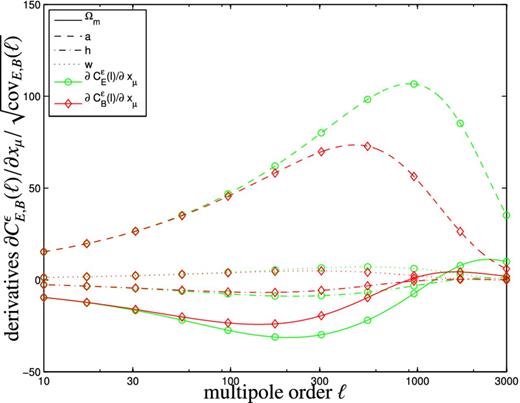
Sensitivities |$\mathrm{\partial} C_E^\epsilon (\ell )/\mathrm{\partial} x_\mu$| (green lines) and |$\mathrm{\partial} C_B^\epsilon (\ell )/\mathrm{\partial} x_\mu$| (red lines) in units of |$\sqrt{\mathrm{cov}_X(\ell )}$| as a function of maximum multipole order ℓ, with respect to the cosmological parameters Ωm (dashed lines), a (solid lines), h (dash-dotted lines) and w (dotted lines). The spectra were computed with the CNPT model.
4.2 Non-Gaussian likelihoods
Any deviation from a Gaussian shape of the likelihood |$\mathcal {L}$| is caused by a non-linear dependence of the spectrum |$C^\epsilon _E(\ell )$| on a model parameter xμ, which is due to the fact that the χ2 functional deviates from a parabolic shape if the model parameter is varied. The likelihood assumes an approximately Gaussian shape if it is sufficiently peaked such that a Taylor expansion of the non-linear parameter dependences is applicable in the region around the fiducial parameter choice. In our case, non-Gaussian shapes have been observed if the summation in equation (40) was restricted to the multipole range 10 ≤ ℓ ≤ 100 and quickly became Gaussian if the summation was carried out to higher multipoles.
The non-Gaussian likelihoods |$\mathcal {L}(\Omega _{\rm m})$| and |$\mathcal {L}(w)$| for the matter density and the dark energy equation of state can be seen in Fig. 5 in comparison to their Gaussian approximation. All likelihoods are centred on the fiducial model value |$x_\mu ^\mathrm{fid}$| and scaled with the width σμ derived with the Fisher formalism. This new normalized variable allows the curves to range in the same interval and to be comparable. Likelihoods have also been normalized to unity. Most notably, the likelihoods are more strongly peaked than their Gaussian counterparts, with slight asymmetries of |$\mathcal {L}(\Omega _{\rm m})$| towards large values and of |$\mathcal {L}(w)$| towards small parameter values. It should be noted, that the misalignment parameter a (together with the disc thickness α) is a linear parameter in our models and its likelihood |$\mathcal {L}(a)$| is always of Gaussian shape. We conclude that the amount of deviation from the ideal shape is not a serious impediment for applying the Fisher formalism for investigating intrinsic alignments, keeping in mind that in reality one observes alignments over a much wider multipole range such that the likelihoods are closer to Gaussianity.
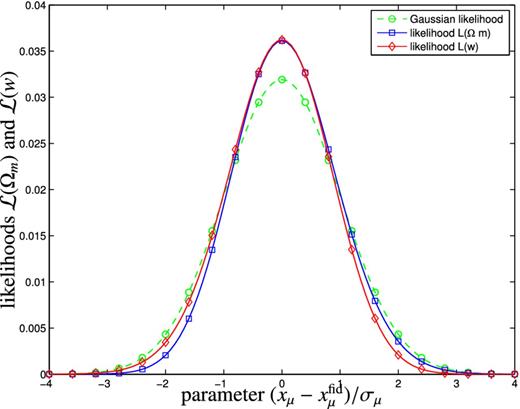
Conditional likelihoods |$\mathcal {L}(\Omega _{\rm m})$| (solid blue line) and |$\mathcal {L}(w)$| (solid red line), along with their Gaussian approximations derived with the Fisher formalism (|$\sigma _\mu = 1/\sqrt{F_{\mu \mu }}$|, dashed green line), for an observation of ellipticity spectrum |$C_E^\epsilon (\ell )$| with the Euclid survey characteristics with all other parameters fixed to their fiducial values. The multipole range was set to 10 ≤ ℓ ≤ 100 and the spectrum |$C^\epsilon _E(\ell )$| entering the likelihood calculation resulted from the CNPT model.
5 INTERFERENCE WITH WEAK LENSING
In this section, we show how the intrinsic alignments can affect measurements of the convergence spectrum by quantifying the parameter biases arising when trying to explain the data consisting of both weak lensing induced ellipticity correlations and intrinsic alignments by a model that only accounts for weak lensing and neglects intrinsic alignments. We consider the case of Euclid's weak lensing survey in a non-tomographic setup and give an estimation of the biases, if intrinsic alignments are not removed from data (as proposed by King 2005; Joachimi & Schneider 2008, 2009) or not properly modelled (King & Schneider 2002, 2003). We aim to supplement previous analysis of intrinsic alignment contaminations such as Hirata & Seljak (2004), Bridle & King (2007) and Kitching, Taylor & Heavens (2008) by using a physically motivated and well described alignment model for spiral galaxies with a small number of parameters which can be accessed by morphological galaxy samples (the disc thickness parameter α) and cosmological simulations (the misalignment parameter a).
5.1 Parameter constraints
The statistical nσ ellipses obtained as cross-sections through the Gaussian-approximated likelihood for all pairs of parameters are shown in Fig. 6 together with the systematical errors in parameter estimation if intrinsic alignments are not taken care of. The extent to which weak lensing parameter likelihoods are Gaussian is investigated in detail by Wolz et al. (2012).
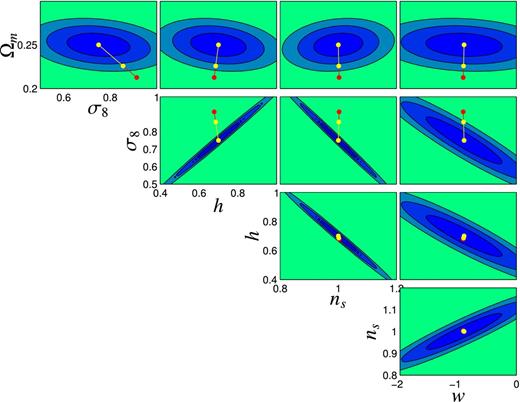
Parameter estimation biases in Ωm, σ8, h, ns and w obtained, respectively, with the CNPT model (in red) and with the MWK model (in yellow) for Euclid's observation of the weak lensing spectrum Cκ(ℓ), which is contaminated by intrinsic alignments |$C_E^\epsilon (\ell )$| on small scales. The misalignment parameter is set to a = 0.25; the disc thickness parameter is set to α = 0.75, the multipole range was 10 ≤ ℓ ≤ 3000 and as a noise amplitude we considered σϵ = 0.3. The ellipses give 1σ, 2σ and 3σ statistical uncertainties on the cosmological parameters from the weak lensing spectrum Cκ(ℓ) from the same multipole range.
5.2 Parameter estimation biases
Fig. 6 shows the biases in the estimation of the cosmological parameters induced by considering the intrinsic ellipticities. We computed the 1σ, 2σ and 3σ ellipses by means of the Fisher matrix, as explained in Section 5.1, and we considered the full range of multipoles going from ℓmin = 10 to ℓmax = 3000 well into the noise-dominated regime. We calculated the biases for both the CNPT and the MWK models of the intrinsic alignments: in what concerns the CNPT model we considered the value of the misalignment parameter found in n-body simulations (Lee & Pen 2000) a = 0.25, and α = 0.75 for the thickness of the disc. The biases are shown, respectively, in red for the CNPT model and in yellow for the MWK model. All parameters apart from the dark energy equation of state w and the slope ns are significantly biased with h to a lesser degree, and in almost all cases the shift is not along the primary statistical degeneracy. The differences in the biases between the CNPT and MWK models reflect the difference in amplitude they predict, which is in our case due to the choice of normalization.
The first thing to notice is how the biases depend on the parameters. Evidently Ωm and σ8, parameters on which the convergence spectrum Cκ(ℓ) highly depends, seem to be mostly affected. This is in line with the fact that the presence of |$C^\epsilon _E(\ell )$| increases the normalization and adds power to the high-ℓ part of the spectrum, therefore requiring larger values of σ8, but also causes a tilting of the spectrum which instead asks for lower Ωm values. The other parameters are instead very weakly affected by the presence of intrinsic alignments.
5.3 Scaling of the estimation bias
It is necessary to investigate how the estimation bias scales with the normalization of the intrinsic alignment spectra, as the parameters a and α in the CNPT model and the resulting normalization C in the MWK model have a large uncertainty. It is worth recalling that the misalignment parameter a is measured in n-body simulations of structure formation, and the galaxy disc thickness α is taken from data on galaxy morphologies.
In Fig. 7, we focus on the CNPT model, by plotting the biases in units of the conditional error |$\sigma _{\mu }^2 = 1/F_{\mu \mu }$| as a function of the misalignment parameter a while keeping α fixed at 0.75. An increasing value of a means a higher misalignment between shear and inertia tensors (Lee & Pen 2000; Crittenden et al. 2001; Schäfer 2009), and hence a higher correlation between angular momenta, or, differently phrased, less randomness in their directions. This means that, within the model, the angular momenta trace the underlying tidal shear field in a tighter way. The lower limit a = 0 indicates therefore complete randomness and absence of any link of the angular momenta to the gravitational potential, as described in Lee & Pen (2000). It is visible how the biases grow fast for greater values of the parameter a, simply meaning that stronger intrinsic correlations would represent a stronger contamination to the convergence spectrum, but that for very large values of a the dependence of the parameter estimation bias with a is saturated and it evolves weaker with increasing a, and even decreases in the case of the parameter ns. Given the fact that the estimation biases δμ/σμ change by almost two decades as a is varied, it is vitally important to determine a beforehand, either from independent observations or from simulations of structure formation.
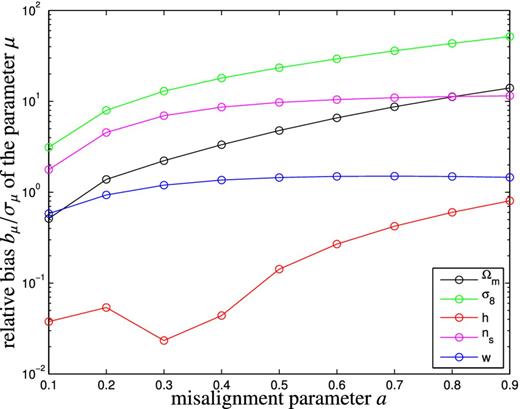
Biases bμ in units of the statistical error σμ for the cosmological parameters Ωm (black line), σ8 (green line), h (red line), ns (magenta line) and w (blue line), as a function of the misalignment parameter a of the CNPT model.
5.4 Observations of intrinsic alignments
Another approach to gain information about the intrinsic alignments relies on the subtraction of the weak lensing signal from the overall signal that is measured. This is, roughly speaking, the inverse of what is usually done with nulling techniques (for details see Joachimi & Schneider 2008, 2009, 2010), whose aim is to clear up the weak lensing signal from intrinsic alignments. The idea behind this is that if we know with high accuracy the model describing the cosmology, we can then predict how, according to this model, the weak lensing spectrum must be. By subtracting the latter from the measured spectrum, the remaining part is ascribable to intrinsic ellipticities. More precisely, if the uncertainty on the convergence power spectrum is small enough to still allow for the extraction of the intrinsic ellipticity signal, then it means that we will be able, in future surveys, to notice this weak signal in the presence of the much stronger weak lensing spectrum.
It is worth to remark, at this point, that the intrinsic alignments we consider in this work, also known as intrinsic–intrinsic alignments, are not the only contaminant to the weak lensing spectrum, usually referred to as the gravitational shear–gravitational shear signal. For instance, another source of contamination is the gravitational shear–intrinsic ellipticity (GI) correlations, which might occur when the alignment produced by a dark matter halo on a close-by galaxy correlates with the shear signal that the same halo induces on a background galaxy. This effect, first suggested by Hirata & Seljak (2004), is difficult to remove, and is not considered in our treatment. Likewise, we do not consider complications arising from the statistical uncertainty in estimating the combined spectrum |$C_\kappa (\ell )+C^\epsilon _E(\ell )$|.
Fig. 8 shows the uncertainties n × ΔCκ(ℓ) with n = 1, …, 5 obtained by using this technique. The likelihood from which samples on the wCDM-parameter set including Ωm, σ8, h, ns and w were drawn is the one describing the knowledge on the cosmological parameters if Euclid's measurement of baryon acoustic oscillations (BAO), Euclid's weak lensing data (both in a 10-bin tomographic measurement) and Planck's cosmic microwave background (CMB) data were present, with a theoretical prior on spatial flatness. The Planck-likelihood was marginalized over the baryon density Ωb. The error tube ΔCκ(ℓ) can be clearly separated into two multipole ranges, the first region where the linear CDM spectrum is dominating in the generation of the weak lensing spectrum, and the second region where the non-linear enhancement of P(k) is important and where the error tube is much wider.
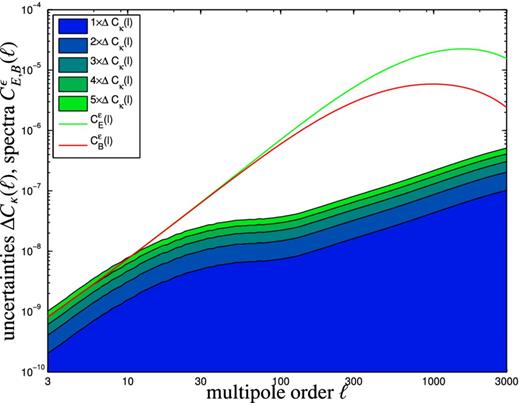
Uncertainties ΔCκ(ℓ) (shaded area) in the prediction of the non-linear weak lensing spectra Cκ(ℓ) from drawing samples for Ωm, σ8, h, ns and w from a Gaussian parameter likelihood, for which we use a prior on the wCDM model combining BAO, lensing and the CMB (Euclid 10-bin BAO spectra, Euclid 10-bin weak lensing spectra and Planck CMB temperature and polarization spectra). The uncertainty is compared to the ellipticity spectra |$C_E^\epsilon (\ell )$| (green line) and |$C_B^\epsilon (\ell )$| (red line) determined with the CNPT model.
We would like to point out that for the statistical subtraction scheme to work the description of the lensing spectrum, in particular of the non-linear part, needs to be unbiased relative to the true non-linear lensing spectrum. Using an analytical formula might be simplistic and we used the analytical description because of the ease of use, while in the true application using a parametrized CDM spectrum derived from simulations might be the best way to proceed. In fact, the cosmic emulators have found a discrepancy of 5-10 per cent between the analytical formula and simulations (Heitmann et al. 2009, 2010; Lawrence et al. 2010).
With such small uncertainties and with the choice of a cosmological model with low complexity the predictive uncertainty on Cκ(ℓ) is much smaller than the amplitude of the intrinsic alignments from multipoles of ℓ ≃ 30 on, |$\Delta C_\kappa (\ell )\ll C^\epsilon _E(\ell )$|. We verified that the Planck CMB likelihood alone would not be sufficient for extracting the intrinsic ellipticity spectrum. Likewise, a more complex model with a larger number of parameters would have much larger uncertainties, |$\Delta C_\kappa (\ell )\gg C^\epsilon _E(\ell )$| for most of the multipole range.
6 SUMMARY
Subject of this paper is the statistical properties of intrinsic, angular momentum induced ellipticity alignments, and their dependence on the cosmological parameter set, in comparison to ellipticity correlations induced by weak gravitational lensing. We carry out our computations with the Euclid ellipticity data sample in mind, and use the projected Euclid galaxy redshift distribution and shape noise for making forecasts.
We base our predictions for the spectra |$C_E^\epsilon (\ell )$| and |$C_B^\epsilon (\ell )$| describing fluctuations in the ellipticity field on physical models for angular momentum correlations in the large-scale structure (Crittenden et al. 2001; MWK). The two models under consideration link the angular momentum field to the tidal shear field, and model the ellipticity of a galaxy by assuming that the galactic disc is formed perpendicular to the host halo's angular momentum direction. The two models differ in describing these physical processes in configuration space versus Fourier space, and use different normalizations. For comparability, we have normalized the MWK model such that it displays the same amplitudes as the CNPT model on large angular scales. The CNPT model in turn uses three parameters, which are the mass scale of the galaxies, imposed by an Gaussian filter acting on the CDM spectrum P(k), a misalignment parameter a, which is determined to have the numerical value a ≃ 0.25 in numerical simulations (Lee & Pen 2001) and finally the disc thickness parameter α, which has been measured to be α ≃ 0.75 in the APM-galaxy sample (Crittenden et al. 2001).
Computing the ellipticity spectra |$C_E^\epsilon (\ell )$| and |$C_B^\epsilon (\ell )$| for the galaxy sample of Euclid from both models yields spectra which are constant on large angular scales and drop off exponentially on small scales, while the E-mode spectrum is larger by about an order of magnitude compared to the B-mode spectrum on multipoles of ℓ ≃ 1000. By themselves, the spectrum |$C_E^\epsilon (\ell )$| would be significantly larger than the linear weak lensing convergence spectrum Cκ(ℓ), which is comparable in amplitude to the spectrum |$C_B^\epsilon (\ell )$| on these multipoles. Non-linear structure formation, however, increases the variance of the cosmic density field strongly, such that intrinsic ellipticities contribute only ∼20 per cent to the total variance of the ellipticity field at ℓ = 1000. Aperture weighted variances give a similar impression: the averaged shear and the aperture mass of the non-linear weak lensing convergence dominate the variance on all relevant scales, and intrinsic alignments are smaller by at least a factor of 2 in this observable.
Investigating the dependence of the ellipticity spectra on cosmological parameters gives a result very different compared to other cosmological probes. Due to the dependence of the angular momentum field on the angular momentum direction and not the magnitude, σ8 is entirely replaced by the misalignment parameter a. ns, Ωm and h determine the CDM spectrum P(k) (the latter two by fixing the shape parameter Γ) and Ωm is of course appearing in the conversion between comoving distance and redshift at the stage of applying the Limber equation. Computing the derivatives |$\mathrm{\partial} C_E^\epsilon (\ell )/\mathrm{\partial} x_\mu$| and |$\mathrm{\partial} C_B^\epsilon (\ell )/\mathrm{\partial} x_\mu$| of the spectra with respect to the cosmological parameters and expressed in units of their covariance suggests that the parameters a and Ωm are the ones most important for intrinsic alignments, with only minor dependences on the dark energy equation of state w and the Hubble parameter h. At the same time Ωm and σ8 are the ones best constrained by lensing, so that it is suggestive to expect the largest estimation biases in those two parameters, if the intrinsic alignments are not properly removed or modelled.
In the next step, we quantified the likelihood |$\mathcal {L}(\Omega _{\rm m},a,w)$| of the intrinsic alignment spectrum |$C_E^\epsilon (\ell )$| if lensing was not present. One could expect this likelihood to have non-Gaussian contributions because of the non-linearities present in an angular momentum-based alignment model: first, the angular momentum depends on the quadratic tidal shear and the ellipticity depends on the squared angular momentum direction. For a restricted multipole ℓmax ≲ 100 range, one can see clear deviations from Gaussianity, which quickly vanish if the multipole range is extended. The misalignment parameter a, which describes the normalization of the spectra, is described by a Gaussian likelihood and enters as a prefactor.
We compute estimation biases on the wCDM parameter set if intrinsic alignments are not removed from the ellipticity spectrum, i.e. if the data are in reality described by |$C_\kappa (\ell )+C_E^\epsilon (\ell )$| and wrongly fitted by Cκ(ℓ) only. The strongest biases are present in Ωm, which is measured to low and σ8, which is estimated too high, both at the level of ∼2σ, making the estimation biases significant. Interestingly, the dark energy equation of state is almost unbiased, indicating that dark energy investigations are not directly affected by intrinsic alignments. Changing the magnitude of the intrinsic alignment contamination by increasing the misalignment parameter a shows a monotonic increase of the estimation biases for all parameters except ns, where the estimation bias saturates at a ≃ 0.5 and drops for higher amplitudes. Clearly, these results demand a good external prior on a, either from independent measurements or from numerical simulations.
Finally, we investigate if the weak lensing convergence spectrum Cκ(ℓ) can be predicted precisely enough such that a deviation can be attributed to a contribution |$C_E^\epsilon (\ell )$|. For this purpose, we develop a technique for propagating the uncertainty in the set of cosmological parameters to the variance ΔCκ(ℓ)2 around Cκ(ℓ) for the fiducial cosmology. Comparing this uncertainty with the amplitudes |$C_E^\epsilon (\ell )$| suggests that it should be measurable at high multipoles. In this process, we used a Gaussian likelihood |$\mathcal {L}$| on a standard wCDM cosmology reflecting the knowledge on the cosmological parameters from Euclid's BAO- and weak lensing spectra and from the temperature and polarization spectra of the CMB measured by Planck.
We plan to extend our research to the intrinsic alignment contamination of tomographic weak lensing data, and to include cross-correlations between the weak lensing shear and the intrinsic ellipticity field, the so-called GI alignments, which we aim to derive from angular momentum-based alignment models and which enter the ellipticity spectra at higher order. These GI-alignments are challenging to describe as they introduce ellipticity correlations across tomography bins and reduce amplitude from the spectra because of the negative cross-correlation between intrinsic ellipticity and gravitational shear. Additionally, we aim to include a linear alignment model for elliptical galaxies and to work with a proper morphological mix of ellipticities, working towards a more complete physical description of alignments in tomographic weak lensing data.
Fisher matrices for the description of parameter constraints forecast for Euclid's tomographic weak lensing survey and Euclid's BAO measurements are taken from the iCosmo resource, and the corresponding Fisher matrix for Planck's CMB spectrum has been kindly provided by Maik Weber and Youness Ayaita. We would like to thank Matthias Bartelmann, Angelos F. Kalovidouris and Vanessa M. Böhm for their suggestions, and are grateful for feedback from Anaïs Rassat and Lukas Hollenstein. FC receives funding through German Research Foundation's (DFG's) Schwerpunktprogramm SPP1177 and PMM is supported by the Graduate Academy, Heidelberg. Both FC and PMM acknowledge support from the International Max Planck Research School for Astronomy and Cosmic Physics in Heidelberg and from the Graduate School of Fundamental Physics. BMS's work was supported by the DFG within the framework of the excellence initiative through the Heidelberg Graduate School of Fundamental Physics. We thank our referee for the helpful remarks that led to significant improvement of the draft.



